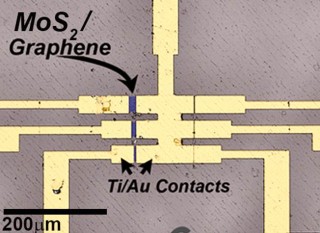Making New Materials an Atomic Layer at a Time

Yu-Chuan Lin, Penn State A photosensor fabricated on the MoS2/graphene heterostructure
This highly scalable technique, often used in the semiconductor industry, can produce new materials with unique properties that could be applied to solar cells, ultracapacitors for energy storage, or advanced transistors for energy efficient electronics, among many other applications.
“People have been trying to stack these layered materials using the scotch tape method (an exfoliation method developed by Nobel laureates Novoselov and Geim to produce graphene), but that leaves residue on the layers and is not scalable,” explains Joshua Robinson of Penn State, corresponding author on a recent article published online in ACS Nano. Other groups have utilized the chemical vapor deposition method to grow layered materials on a copper substrate, but this method requires some sophisticated techniques to transfer the layered material to a more functional substrate without causing tears or contamination.
Robinson and his colleagues employed a more direct method, using chemical vapor deposition to grow a layer of quasi-free-standing epitaxial graphene (QFEG) on a silicon carbide substrate, followed by a layer of molybdenum disulfide (MoS2), a metal dichalcogenide compound widely used as a lubricant. In order to test the quality of the MoS2 on graphene, the researchers used the material to build a photodetector device to measure the layered material’s efficiency at converting photons to electrons. They found that the response of the MoS2/QFEG material was 100 times higher than MoS2 alone.
For devices, the QFEG method, which introduces a layer of hydrogen atoms between the substrate and the graphene and thereby decouples the graphene layer from the underlying silicon carbide, proved to be a better choice than the more standard as-grown graphene. Robinson says, “In general QFEG is more interesting, and from a device point of view, it’s critical.”
To see if quasi-free-standing graphene was a suitable template for the growth of other artificially stacked atomic layers, the team synthesized two other van der Waals solids: tungsten diselenide, and hexagonal boron nitride. (van der Waals solids have strong in-plane bonding but weak interlayer bonding.) They determined that epitaxial graphene was “an excellent candidate for building large-area vdW solids that will have extraordinary properties and performances.”
Industry has already shown strong interest in 2D layered materials for RF applications, low-power and low-cost semiconductors, and for displays on flexible substrates. “This is the first step,” Robinson says. “To truly control properties we will need to look at a variety of these systems that should turn out to have entirely new properties when stacked together.”
Contributors to the ACS Nano article, “Direct Synthesis of van der Waals Solids,” are lead author Yu-Chuan Lin, a Ph.D. candidate in Robinson’s group, Nestor Perea-Lopez, Jie Li, Zhong Lin, Chia Hui Lee, Lazaro Calderon, Paul N. Brown, Michael S. Bresnehan, Theresa Mayer, Mauricio Terrones, and Joshua Robinson, all of Penn State, and Ning Lu, Xin Peng, Ce Sun, and Moon J. Kim, all of University of Texas at Dallas. The work at Penn State and UT Dallas was supported by the Center for Low Energy Systems Technology (LEAST), and by the National Nanotechnology Infrastructure Network at Penn State. Contact Joshua Robinson at jar403@psu.edu. For more information on 2D materials, visit the Penn State Center for 2-Dimensional and Layered Materials at mri.psu.edu/centers/2dlm/. (DOI: 10.1021/nn5003858)
Media Contact
All latest news from the category: Materials Sciences
Materials management deals with the research, development, manufacturing and processing of raw and industrial materials. Key aspects here are biological and medical issues, which play an increasingly important role in this field.
innovations-report offers in-depth articles related to the development and application of materials and the structure and properties of new materials.
Newest articles

High-energy-density aqueous battery based on halogen multi-electron transfer
Traditional non-aqueous lithium-ion batteries have a high energy density, but their safety is compromised due to the flammable organic electrolytes they utilize. Aqueous batteries use water as the solvent for…

First-ever combined heart pump and pig kidney transplant
…gives new hope to patient with terminal illness. Surgeons at NYU Langone Health performed the first-ever combined mechanical heart pump and gene-edited pig kidney transplant surgery in a 54-year-old woman…

Biophysics: Testing how well biomarkers work
LMU researchers have developed a method to determine how reliably target proteins can be labeled using super-resolution fluorescence microscopy. Modern microscopy techniques make it possible to examine the inner workings…





















